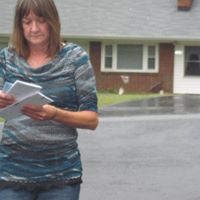Which is the flow of water that occurs when excess meltwater flows over the Earth's surface?
Surface runoff (also known as overland flow) is the flow of water that occurs when excess stormwater, meltwater, or other sources flow over the Earth's surface. This can occur when the soil is saturated to full capacity, and rain arrives more quickly than soil can absorb it.
Surface runoff often occurs because impervious areas (such as roofs and pavement) do not allow water to soak into the ground. Surface runoff is a major component of the water cycle. It is the primary agent of soil erosion by water. The land area producing runoff that drains to a common point is called a drainage basin.
Runoff that occurs on the ground surface before reaching a channel can be a nonpoint source of pollution, as it can carry man-made contaminants or natural forms of pollution (such as rotting leaves). Man-made contaminants in runoff include petroleum, pesticides, fertilizers and others.
In addition to causing water erosion and pollution, surface runoff in urban areas is a primary cause of urban flooding, which can result in property damage, damp and mold in basements, and street flooding.
More Info:
en.wikipedia.org










